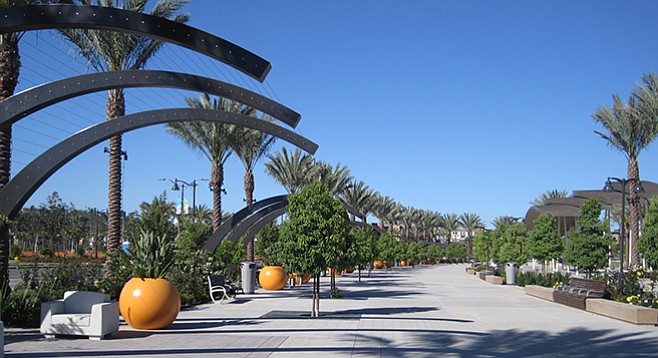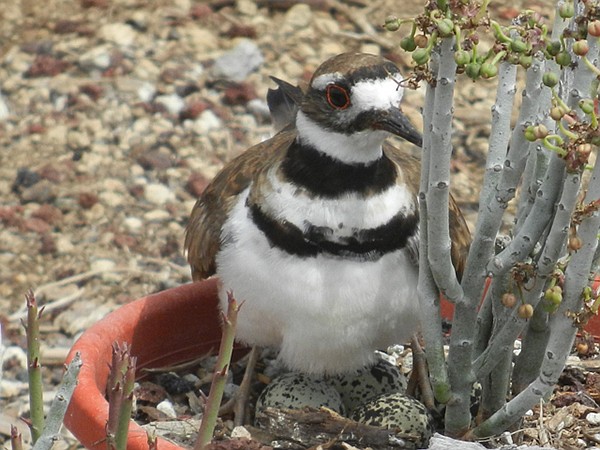 Facebook
Facebook
 X
X
 Instagram
Instagram
 TikTok
TikTok
 Youtube
Youtube

Built on a 70-year old sand-and-gravel quarry, Civita Park is a work-in-progress that will total 14.3 park acres centrally located in a 230-acre residential development. The top and bottom sections opened during Arbor Day weekend with the central section under construction. In the future, the park will be accessible via the Rio Vista Trolley station. This will complete the Grant family legacy of a walkable village centered on a large public park plus 17 acres of riverfront property deeded to the San Diego River Park Foundation.
Franklin and Alta Grant moved to San Diego from South Dakota in 1912. In the 1920s their first property was along the San Diego River in Mission Valley, just east of the present Qualcomm Way. They soon purchased property north of Friars Road where the family owned the sand-and-gravel quarry, a local source of aggregate used in many San Diego projects ranging from Lindbergh Field runways to Petco Park.

Choices of wide level walkways start from the parking lot. Some bypass the stairs on the east side of the park giving an option for those with wheelchairs or strollers. The exception to this is at the top where the Civita Falls Promenade steps cascade down from Via Alta. Low-water-use plants, including native species, are found along the walkways.

Look for killdeer (Charadrius vociferus) on the barren sections of the western slope as they scratch the ground for insects. These shorebirds are common around human habitation and dry areas where there is either sparse or no vegetation. They are attractive plovers that are dark tan on top and white below with two black bands on their chest, a brown head with white patches, and a black band at eye level. Juveniles differ from adults in having only one neckband with all having an orange-red eye ring and rump that is seen during flight and displays.
Killdeer nests are scrapes where other mostly light-colored materials are added after the eggs are laid. Both parents incubate the eggs and during hot days may soak their belly feathers to cool the eggs. This ground forager of insects is well known to use the broken-wing display to lead predators from their nests, although in some cases will fluff up to look larger while charging. During flight their noisy call is the high-pitched kill-deer and when alarmed the sound truncates to a dee or trill sound.
Civita Park is a work-in-progress with an outdoor amphitheater, community garden, picnic areas, multipurpose fields, half-basketball courts, gardens, and a dog park with separate sections for small and large dogs.
Distance from downtown San Diego: Approximately 5.5 miles (Mission Valley). Allow 15 minutes driving time. From SR-163 N, take exit 3B to Friars Road east and turn left onto Mission Center Road. Turn right onto Civita Boulevard, then left again at Russell Parkway into the parking lot.
Hiking length: Approximately 2 miles. Total walking distance will change as more of the park opens.
Difficulty: Easy, with approximately 300 feet of elevation gain/loss. Dogs on leashes allowed.


Built on a 70-year old sand-and-gravel quarry, Civita Park is a work-in-progress that will total 14.3 park acres centrally located in a 230-acre residential development. The top and bottom sections opened during Arbor Day weekend with the central section under construction. In the future, the park will be accessible via the Rio Vista Trolley station. This will complete the Grant family legacy of a walkable village centered on a large public park plus 17 acres of riverfront property deeded to the San Diego River Park Foundation.
Franklin and Alta Grant moved to San Diego from South Dakota in 1912. In the 1920s their first property was along the San Diego River in Mission Valley, just east of the present Qualcomm Way. They soon purchased property north of Friars Road where the family owned the sand-and-gravel quarry, a local source of aggregate used in many San Diego projects ranging from Lindbergh Field runways to Petco Park.

Choices of wide level walkways start from the parking lot. Some bypass the stairs on the east side of the park giving an option for those with wheelchairs or strollers. The exception to this is at the top where the Civita Falls Promenade steps cascade down from Via Alta. Low-water-use plants, including native species, are found along the walkways.

Look for killdeer (Charadrius vociferus) on the barren sections of the western slope as they scratch the ground for insects. These shorebirds are common around human habitation and dry areas where there is either sparse or no vegetation. They are attractive plovers that are dark tan on top and white below with two black bands on their chest, a brown head with white patches, and a black band at eye level. Juveniles differ from adults in having only one neckband with all having an orange-red eye ring and rump that is seen during flight and displays.
Killdeer nests are scrapes where other mostly light-colored materials are added after the eggs are laid. Both parents incubate the eggs and during hot days may soak their belly feathers to cool the eggs. This ground forager of insects is well known to use the broken-wing display to lead predators from their nests, although in some cases will fluff up to look larger while charging. During flight their noisy call is the high-pitched kill-deer and when alarmed the sound truncates to a dee or trill sound.
Civita Park is a work-in-progress with an outdoor amphitheater, community garden, picnic areas, multipurpose fields, half-basketball courts, gardens, and a dog park with separate sections for small and large dogs.
Distance from downtown San Diego: Approximately 5.5 miles (Mission Valley). Allow 15 minutes driving time. From SR-163 N, take exit 3B to Friars Road east and turn left onto Mission Center Road. Turn right onto Civita Boulevard, then left again at Russell Parkway into the parking lot.
Hiking length: Approximately 2 miles. Total walking distance will change as more of the park opens.
Difficulty: Easy, with approximately 300 feet of elevation gain/loss. Dogs on leashes allowed.
Comments